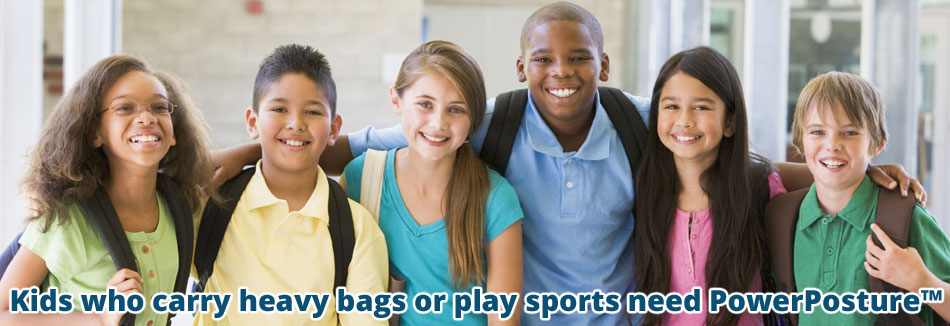
PowerPosture™ - A Necessity for Optimum Triathlon Performance
 |
| PowerPosture™ was Reviewed and recommended in the April, 2000 issue of Triathlete Magazine in the Indus-Tri section on page 32 |
If you do not have the muscle flexibilities and strength balances to hold proper, efficient posture all the time, without thinking about it, you will never reach your potential in triathlon, no matter how hard you train!
For all the training you do, and the thousands of dollars you spend on equipment and travel, wouldn't it be a shame to never reach your potential, just because of something as basic as inefficient posture and inadequate flexibility?
Look at the posture of virtually any world-class athlete, in any sport which requires high level work output. From track to swimming to triathlon to power lifting, the very best have good posture all the time! The reason is that when you have proper posture as the result of proper muscle flexibilities and strength balances around the body, you can produce the maximum speed, strength, and endurance you are capable of in most physical activities.
(If a top-level competitor has poor posture, it does not disprove the need for good posture. Rather, it is a demonstration of how much talent and training he/she has, to be that good despite poor posture. With proper posture and flexibility, he/she would be even better!)
Within fairly narrow limits, proper postural alignment is the earlobe over the middle of the shoulders, over the hip joint, and over a point about an inch in front of the ankle joint. This alignment will be produced when:
- The shoulders are held back and down
- The upper back is relatively flat between the shoulder blades, the shoulder blades are flush with the rest of the back, and the upper spine curves forward only slightly
- The chest curves out, so that the forward edges of the shoulders are 1 or more inches behind a yardstick placed across the upper chest
- The collar bones are level or slope only slightly upwards
- The chin is 3 or more inches above the outer tips of the level collar bones or the sternal notch (the hollow at the base of the neck, above the breast bone).
This postural standard pertains to people of all ages. There is no research evidence that as one ages normally, posture has to get worse, nor that upper body flexibility has to get worse. Unless a person specifically has a disease which causes spinal degeneration, posture can and should be as straight at age 80 as at age 20. The posture of older international-level age-group triathletes is usually indistinguishable from that of younger competitors!
Overall, there are many advantages to proper posture and flexibility:
- Optimal organ and muscle function, producing maximum energy, endurance, and vigor
- Optimal biomechanics, for the best possible muscle performance
- A neck, shoulders, and upper back which are no more fatigued or painful than the rest of the body at the end of the day, or at the end of a long drive, even a drive many days long
- Greater concentration and mental abilities, as the results of reducing or eliminating fatigue and pain
- Fewer upper and lower back problems
- Little or no height loss with age
- A flatter and stronger stomach - in fact, without proper posture, you can never achieve the flattest stomach and smallest waist possible
- A more respect-producing, confident, competent, vigorous, youthful appearance
However, instead of proper posture, most triathletes (as with most adults) stand and walk with their head thrust forward (forward head, "text neck" posture), their shoulders hunched forward, their upper back rounded, and their chest sunken in.
Forward head, round shouldered, curved upper back posture produce the following bodily adaptations which decrease triathlon performance:
- Decreased neck rotation range left and right, and decreased upward rotation range (a major safety concern in cycling and many other activities where all-around vigilance is necessary).
- Lung residual volume increases with a rounded upper back and a sunken chest, decreasing breathing efficiency
- Muscles of the chest and of the front of the shoulders shorten and tighten, which:
a. Decreases potential chest power development in swimming
b. Decreases endurance by increasing breathing work
c. May decrease breathing depth, making it less efficient
d. Pushes the ribcage down, which makes the stomach protrude and weakens it - Upper back and back of shoulder muscles lengthen and loosen, which:
a. Weakens them, thereby reducing swimming power.
b. Makes them fatigue more easily - Neck, back, and shoulder muscle loading increases, which:
a. Overdevelops those muscles, adding unnecessary body weight
b. Makes those muscles work harder and fatigue quicker
c. Diverts oxygen from the working legs or arms, decreasing performance
d. Makes upper back muscles and spine more injury prone
e. Increases risk for temporomandibular (jaw) joint problems, affecting all physical activities.
f. Increases load on the cervical spine, risking ruptured discs and pinched nerves - Lower spine curvature changes to compensate for the excessive forward curvature of the upper spine, which:
a. Weakens and overloads the lower back
b. Can cause chronic lower back pain
c. Worsens existing lower back problems
d. May alter pelvic position, which can reduce running efficiency
OVERALL, triathlon performance is reduced by forward head, round shouldered posture because:
- Reduced overall biomechanical efficiency and hindered function of most organs reduce overall physical performance
- Decreased loadbearing capabilities increase injury risk
- Stooped, saggy, and "old" appearancewhich hurts self-perception and confidence, is not intimidating to competitors, and does not convey to others (in competition or in daily life) confidence, competence, vigor, energy, or athleticism.
- Forward head posture overdevelops the upper back and neck muscles, adding unnecessary body weight.
- A forward cantilevered head requires more energy to hold up during cycling and running, which can prematurely fatigue the neck, shoulders, and upper back, and uses oxygen which could otherwise go to the muscles that are generating your forward motion.
- A forward head changes spinal curvature top to bottom, making the body less efficient. Pelvic angle and range of motion may also be affected, which can cause either a too-short or too-long running stride.
- Hunched shoulders impede upward movement of the ribcage during breathing, plus residual volume (the air that you can't get out) is increased, so you need more energy for any given level of breathing.
- Tight chest muscles from chronic forward head posture and hunched shoulders further impede breathing by making it more difficult to expand the ribcage.
- Decreased shoulder range of motion due to tight chest and front of shoulder muscles decrease swim stroke length and strength; and by holding the shoulders forward, they prevent efficient arm recovery and force one to roll excessively to breathe.
- Forward head posture puts the head farther down into the water, also forcing one to roll excessively and/or work harder to get the head out to breathe.
CRITICAL REALIZATION #1:
A triathlete with poor resting posture but who runs with good posture will still have suboptimal performance because to hold that proper posture, she/he must fight against their short chest and shoulder muscles trying to pull them forward into a hunched position.
CRITICAL REALIZATION #2:
No matter how well they train, eat, and rest, anyone who has forward head, round-shouldered posture at rest or during exercise will never perform up to his or her physical potential in triathlon, or in virtually any other sport, because of the physical performance-inhibiting adaptations that posture causes in the body!
Why, then, do most people develop forward head, round-shouldered posture, when (in the absence of degenerative spinal diseases), there is no evidence that posture has to get worse with age? The reasons for most people's poor posture include:
- A "normal, modern" life history of sedentary, hunched forward activities which gradually alter their muscles' flexibilities and ranges of motion.
- No lifelong, regular exercises specifically done to prevent postural degeneration.
- Overemphasis on resistance movements like pushups, situps, and bench press, which overdevelop anterior shoulder, chest, and abdominal muscles and thereby pull the head and shoulders forward and pull the ribcage downward.
In triathletes, there is the additional training factor that both swimming and aero position cycling tend to develop hunched shoulders if specific training to counteract those "hunching influences" is not done. Most triathletes do not do any such counteraction training, not from a lack of caring, but from a lack of awareness and knowledge!
Obviously, for best triathlon performance and overall health, one must prevent or cure forward head posture and all the biophysical changes it causes. The PowerPostureTM Program shows how to cure or prevent all of the deleterious biophysical changes listed in this article. The Program uses gentle, easy-to-do stretching and strengthening exercises which can be done anywhere and anytime (even during recovery intervals in a swim or run), and 1 full session takes only 6 to 10 minutes. The program was painstakingly developed as an integrated whole, so it is highly "effective" (that is, it "produces the effects desired")!
Some triathletes might think they don't need a specific program like PowerPostureTM to reestablish good posture, thinking that they can "just think about it and do it". But this process seldom works, because:
- Good posture alone will only very slowly correct muscle imbalances, and it will not reestablish proper movement range of motion and muscle flexibility.
- When people inevitably stop thinking about posture and slip back into poor posture, they undo some of their progress.
- The only time-effective, assured cure for forward head posture and its associated biophysical changes is active exercise intervention, as with PowerPostureTM.
IN SUMMARY:
- For the best triathlon performance possible within the constraints of lifestyle, family, profession, age, gender, and exercise time available, you must develop and then maintain properly balance neck, shoulder, and upper back muscle flexibilities, muscle strengths, and posture.
- The PowerPostureTM Program develops and then maintains all of the necessary muscle balances and the proper posture for best triathlon performance, so it truly belongs in the training arsenal of anyone who wants to be the best triathlete, as well as the healthiest person, that they can be!


